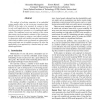Free Online Productivity Tools
i2Speak
i2Symbol
i2OCR
iTex2Img
iWeb2Print
iWeb2Shot
i2Type
iPdf2Split
iPdf2Merge
i2Bopomofo
i2Arabic
i2Style
i2Image
i2PDF
iLatex2Rtf
Sci2ools
DATE
2004
IEEE
2004
IEEE
Workload Characterization Model for Tasks with Variable Execution Demand
The analysis of real-time properties of an embedded system usually relies on the worst-case execution times (WCET) of the tasks to be executed. In contrast to that, in real world applications the running time of tasks may vary from execution to execution, e. g. in multimedia applications. The traditional worst-case analysis of the system then returns overly pessimistic estimates of the system performance. In this paper we propose a new effective method to characterize tasks with variable execution requirements, which leads to tighter worst-case bounds on system performance and better use of available resources. We show the applicability of our approach by a detailed study of a multimedia application.
DATE 2004 | Hardware | Multimedia Application | Traditional Worst-case Analysis | Worst-case Execution Times |
Related Content
| Added | 20 Aug 2010 |
| Updated | 20 Aug 2010 |
| Type | Conference |
| Year | 2004 |
| Where | DATE |
| Authors | Alexander Maxiaguine, Simon Künzli, Lothar Thiele |
Comments (0)

